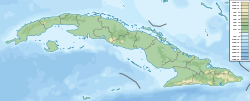| Lagunitas Formation | |
|---|---|
| Stratigraphic range: Burdigalian (Hemingfordian) | |
| Type | Formation |
| Underlies | Güines Formation |
| Overlies | Las Cuevas Formation |
| Lithology | |
| Primary | Claystone, limestone |
| Other | Conglomerate |
| Location | |
| Coordinates | 21°36′N79°30′W / 21.6°N 79.5°W |
| Approximate paleocoordinates | 21°54′N75°42′W / 21.9°N 75.7°W |
| Region | Sancti Spíritus Province |
| Country | Cuba |
| Type section | |
| Named by | Popov |
The Lagunitas Formation is a geologic formation in Cuba. The open marine, fluvio-deltaic and lagoonal claystones, limestones and conglomerates preserve fossils dating back to the Early Miocene period. [1] Among others, the fossil primate Paralouatta marianae , the largest primate of the Miocene New World, was found in the formation. [2] Based on microfossils, the age has been determined as Burdigalian. [3]
